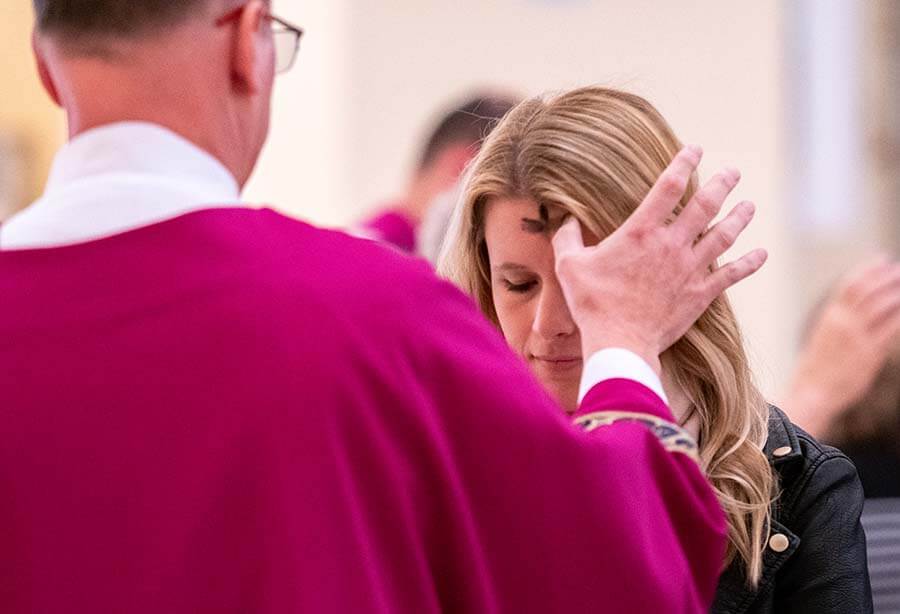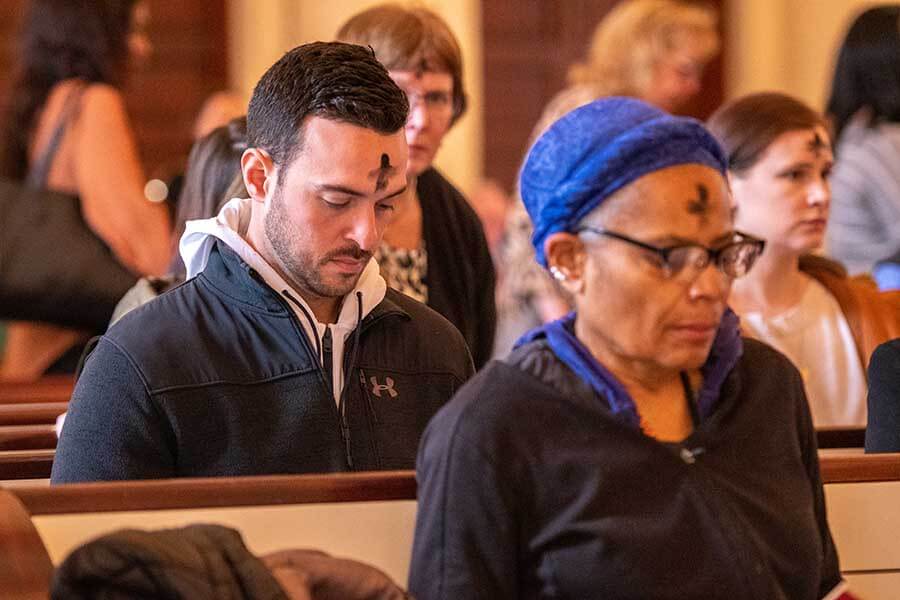
Having attended or worked for Catholic institutions all her life, Sydney West never stood out on Ash Wednesday — until now.
Early on Feb. 26, West left St. Ignatius in Mount Vernon with the signature smudge of the start of Lent and headed to nursing classes at Johns Hopkins University.
“At the beginning of the day, I was a little apprehensive because I didn’t want to walk in somewhere and have this stuff on my head,” West said. “But for me, I thought it was more important to be able to have time for personal reflection and to have the marking on my head like I’ve done probably the entire 28 years of my life.”
Although practiced by other Christian faiths, the tradition of having ashes imposed on the forehead is primarily associated with Catholics. Ash Wednesday may be the one day of the year where observant Catholics are most visible to the rest of the public.
Several figures in the Bible used ashes symbolically and the Christian imposition of ashes, a practice in humility, dates to the early centuries of the church. Yet now more than ever Ash Wednesday may seem at odds with our selfie-obsessed, social-media-wired world.
The ashes, made from the burned palm fronds from the previous year’s Palm Sunday liturgies, represent mortality.
Among the dictums the priest, deacon or layperson says as the ashes are applied include “Remember you are dust and to dust, you shall return” or “Repent and believe in the Gospel.”
Dr. Joshua Brown, an associate theology professor at Mount St. Mary University in Emmitsburg, said the mark of Ash Wednesday is a spiritual cue to help Catholics get into the mindset of Lent, a period of prayer, fasting and almsgiving, to prepare for the death and resurrection of Jesus.

Brown, a parishioner of St. John in Westminster, said although the mark may make Catholics more visible on Ash Wednesday, it’s a message meant to be transmitted inward rather than outward. Think “look inside,” not “look at me,” he said.
“It’s a sign of mourning and grief. And of course, repentance may be part of it,” Brown said. “The ashes help us inform or symbolize the kind of internal processes that we ought to be doing to bring the body into a union with the soul.”
“The ashes are not about the ostentation or the display aspect, but it’s about the spiritual practice itself that we have to be mindful of.”
Indeed, the Gospel reading for Ash Wednesday from Matthew instructs the faithful not to be overt in their almsgiving or prayer.
“Take care not to perform righteous deeds in order that people may see them,” the Gospel passage reads.
Every year, Garrett Koslin, a nurse at Johns Hopkins Hospital, makes a point to attend Ash Wednesday Mass at the Basilica of the National Shrine of the Assumption of the Blessed Virgin Mary in downtown Baltimore, site of his conversion to Catholicism.
Koslin, a 36-year-old parishioner of Church of the Immaculate Conception in Towson, said he works in a very visible ward at Johns Hopkins Hospital and often gets questions about the ashes and Catholicism from patients and colleagues on Ash Wednesdays.
“Wearing them is definitely a badge of faith,” Koslin said. “I get them every year because it’s a very reassuring feeling. It’s beginning on a journey. It makes me reflect on my life. Like, what can I give up from my life and change in my life to be a better person?”
Susan Stewart, 59, and Susan Dunn, 63, attended Ash Wednesday Mass at St. Ignatius before heading to a work conference. Stewart and Dunn mingled with fellow healthcare professionals of all faiths at the event, organized by Centers for Medicaid and Medicare Services – all while marked with the cross.
“It makes me feel very proud to be making a statement that today is Ash Wednesday and we’re starting this journey for 40 days of prayer and almsgiving,” said Stewart, a parishioner of St. Joseph Church in Pittsburgh, Pa.
Dunn, a parishioner at St. Elizabeth Church in Denver, Colo., agreed that the symbolism of the day is important.
“In the secular world, there’s not many reminders of a power called to something bigger so for me Ash Wednesday does that. The challenge is how do you live beyond that today for the next 40 days?” she said.
For more on Lent in the Archdiocese of Baltimore, visit www.archbalt.org/lent
Email Tim Swift at tswift@CatholicReview.org.

